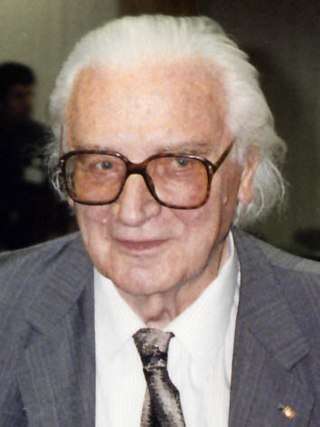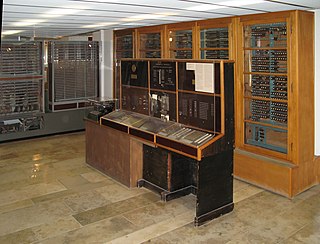
Konrad Ernst Otto Zuse was a German civil engineer, pioneering computer scientist, inventor and businessman. His greatest achievement was the world's first programmable computer; the functional program-controlled Turing-complete Z3 became operational in May 1941. Thanks to this machine and its predecessors, Zuse has often been regarded as the inventor of the modern computer.

The Z3 was a German electromechanical computer designed by Konrad Zuse in 1938, and completed in 1941. It was the world's first working programmable, fully automatic digital computer. The Z3 was built with 2,600 relays, implementing a 22-bit word length that operated at a clock frequency of about 5–10 Hz. Program code was stored on punched film. Initial values were entered manually.

The Dornier Do 17 is a twin-engined light bomber produced by Dornier Flugzeugwerke for the German Luftwaffe during World War II. Designed in the early 1930s as a Schnellbomber intended to be fast enough to outrun opposing aircraft, the lightly built craft had a twin tail and "shoulder wing". Sometimes referred to as the Fliegender Bleistift, it was popular among its crews due to its handling, especially at low altitude, which made the Do 17 harder to hit than other German bombers.

The Ilyushin Il-18 is a large turboprop airliner that first flew in 1957 and became one of the best known and most durable Soviet aircraft of its era. The Il-18 was one of the world's principal airliners for several decades and was widely exported. Due to the aircraft's airframe durability, many examples achieved over 45,000 flight hours and the type remains operational in both military and civilian capacities. The Il-18's successor was the long range Il-62 jet airliner.

Casio Computer Co., Ltd. is a Japanese multinational electronics manufacturing corporation headquartered in Shibuya, Tokyo, Japan. Its products include calculators, mobile phones, digital cameras, electronic musical instruments, and analogue and digital watches. It was founded in 1946, and in 1957 introduced the first entirely compact electronic calculator. It was an early digital camera innovator, and during the 1980s and 1990s, the company developed numerous affordable home electronic keyboards for musicians along with introducing the first mass-produced digital watches.

The Douglas C-124 Globemaster II, nicknamed "Old Shaky", is an American heavy-lift cargo aircraft built by the Douglas Aircraft Company in Long Beach, California.

The North American X-10 was an unmanned technology demonstrator developed by North American Aviation. It was a subscale reusable design that included many of the design features of the SM-64 Navaho missile. The X-10 was similar to the development of the Bell X-9 Shrike project, which was based on features of the GAM-63 RASCAL.

The Z4 was arguably the world's first commercial digital computer. It was designed, and manufactured by early computer scientist Konrad Zuse's company Zuse Apparatebau, for an order placed by Henschel & Son, in 1942; though only partially assembled in Berlin, then completed in Göttingen, and not delivered by the defeat of Nazi Germany, in 1945. The Z4 was Zuse's final target for the Z3 design. Like the earlier Z2, it comprised a combination of mechanical memory and electromechanical logic, so was not a true electronic computer.

The 40.6 cm SK C/34, sometimes known as the Adolfkanone, was a German naval gun, designed in 1934 by Krupp and originally intended for the early H-class battleships.

The North American SM-64 Navaho was a supersonic intercontinental cruise missile project built by North American Aviation (NAA). The final design was capable of delivering a nuclear weapon to the USSR from bases within the US, while cruising at Mach 3 at 60,000 feet (18,000 m) altitude. The missile is named after the Navajo Nation.

The Z1 was a motor-driven mechanical computer designed by Konrad Zuse from 1936 to 1937, which he built in his parents' home from 1936 to 1938. It was a binary electrically driven mechanical calculator with limited programmability, reading instructions from punched celluloid film.

Puerto Rico competed at the 1976 Summer Olympics in Montreal, Quebec, Canada. 80 competitors, 73 men and 7 women, took part in 74 events in 12 sports.

Great Britain, represented by the British Olympic Association (BOA), competed at the 1980 Summer Olympics in Moscow, USSR. British athletes have competed in every Summer Olympic Games. 219 competitors, 149 men and 70 women, took part in 145 events in 14 sports.

Germany competed at the 1996 Summer Olympics in Atlanta, United States. 465 competitors, 278 men and 187 women, took part in 234 events in 26 sports.

The Cessna 188 is a family of light agricultural aircraft produced between 1966 and 1983 by the Cessna Aircraft Company.

Kyrgyzstan competed in the Summer Olympic Games as an independent nation for the first time at the 1996 Summer Olympics in Atlanta, United States. Previously, Kyrgyz athletes had competed for the Unified Team at the 1992 Summer Olympics.

Canada is represented at the 2006 Commonwealth Games in Melbourne by a contingent, comprising 253 sportspersons.

The Hispano Aviación HA-1109 and HA-1112 are licence-built versions of the Messerschmitt Bf 109G-2 developed in Spain during and after World War II.
The South American U18 Championships in Athletics is a biennial athletics event organized by "Confederación Sudamericana de Atletismo" (CONSUDATLE), the South American area association of the International Amateur Athletic Federation (IAAF). Starting in 1973, the competition was open for athletes under-17 in the early years. Since 2000 the international age group definition has applied. Up until the 2016 edition the competition was known as the South American Youth Championships in Athletics. The tournament is open for athletes from CONSUDATLE member federations. Athletes from IAAF members of other geographical areas may be invited. However, they are not considered in the classification.

Orbit Beyond, Inc., usually stylized as ORBITBeyond, is a aerospace company that builds technologies for lunar exploration. Its products include configurable delivery lunar landers with a payload capacity of up to 300 kg (660 lb), and rovers. The company will contract for private rocket launch services.



















